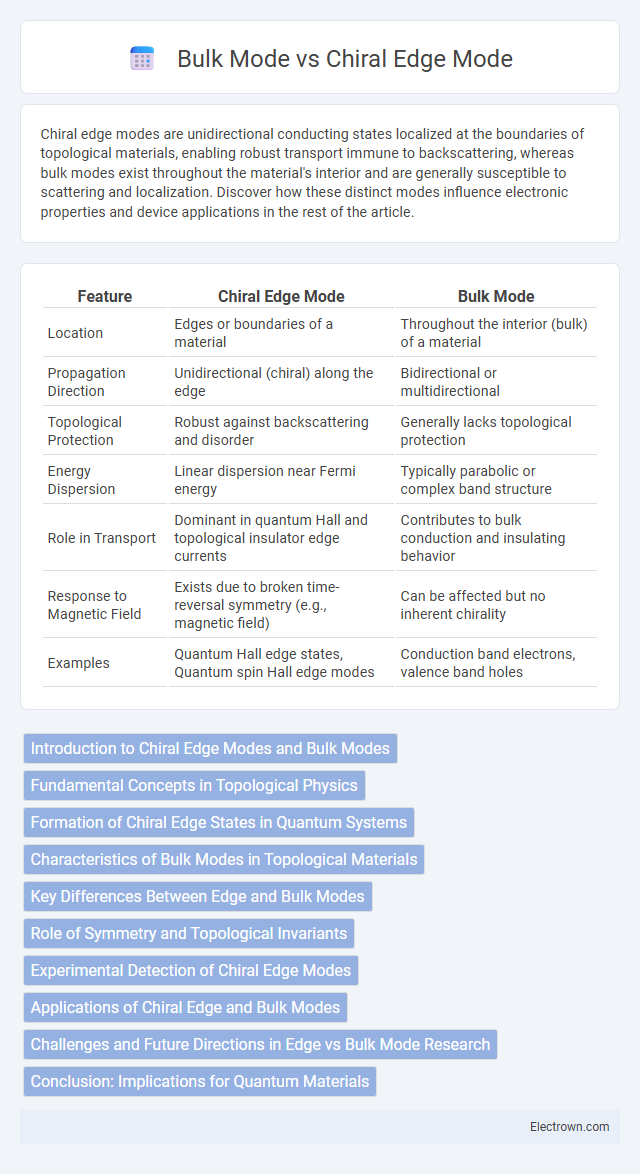Chiral edge modes are unidirectional conducting states localized at the boundaries of topological materials, enabling robust transport immune to backscattering, whereas bulk modes exist throughout the material's interior and are generally susceptible to scattering and localization. Discover how these distinct modes influence electronic properties and device applications in the rest of the article.
Table of Comparison
| Feature | Chiral Edge Mode | Bulk Mode |
|---|---|---|
| Location | Edges or boundaries of a material | Throughout the interior (bulk) of a material |
| Propagation Direction | Unidirectional (chiral) along the edge | Bidirectional or multidirectional |
| Topological Protection | Robust against backscattering and disorder | Generally lacks topological protection |
| Energy Dispersion | Linear dispersion near Fermi energy | Typically parabolic or complex band structure |
| Role in Transport | Dominant in quantum Hall and topological insulator edge currents | Contributes to bulk conduction and insulating behavior |
| Response to Magnetic Field | Exists due to broken time-reversal symmetry (e.g., magnetic field) | Can be affected but no inherent chirality |
| Examples | Quantum Hall edge states, Quantum spin Hall edge modes | Conduction band electrons, valence band holes |
Introduction to Chiral Edge Modes and Bulk Modes
Chiral edge modes are unidirectional states localized at the boundaries of topological insulators, characterized by robust conductivity that resists backscattering even in the presence of defects. Bulk modes exist throughout the interior of materials and exhibit bidirectional propagation with energy dispersions that depend on the material's band structure. The distinction between chiral edge modes and bulk modes underpins topological protection phenomena critical for quantum Hall effects and spintronic applications.
Fundamental Concepts in Topological Physics
Chiral edge modes arise at the boundaries of topological insulators due to the nontrivial topological order in the bulk band structure, enabling unidirectional, dissipationless transport that is robust against disorder. In contrast, bulk modes exist within the interior of the material and typically exhibit bidirectional propagation susceptible to scattering. Understanding your system's edge versus bulk mode behavior is crucial for designing devices that leverage topological protection in electronic and photonic technologies.
Formation of Chiral Edge States in Quantum Systems
Chiral edge states form at the boundaries of topological insulators and quantum Hall systems due to the nontrivial topology of the bulk band structure, characterized by a non-zero Chern number. These states propagate unidirectionally along the edge, immune to backscattering from disorder, contrasting with bulk modes that exhibit bidirectional propagation and are susceptible to localization. The existence of chiral edge modes is a direct consequence of the bulk-boundary correspondence principle, linking the topological invariants in the bulk to robust conducting channels at the system edges.
Characteristics of Bulk Modes in Topological Materials
Bulk modes in topological materials exhibit energy states that extend throughout the entire volume of the material, allowing electron wavefunctions to propagate in all directions. These modes are typically gapped and lack the directional robustness inherent to chiral edge modes, resulting in susceptibility to scattering and localization from impurities. The bulk states determine the topological phase of the material by hosting band structures characterized by topological invariants such as Chern numbers or Z2 indices.
Key Differences Between Edge and Bulk Modes
Chiral edge modes propagate unidirectionally along the boundaries of topological materials, exhibiting robustness against backscattering due to topological protection. Bulk modes, in contrast, extend throughout the material's interior and typically allow bidirectional propagation, making them more susceptible to scattering and localization. Understanding these key differences enables your effective manipulation of electronic transport properties in topological insulators and related systems.
Role of Symmetry and Topological Invariants
Chiral edge modes arise from the breaking of time-reversal symmetry and are protected by nontrivial topological invariants such as the Chern number, guaranteeing robust unidirectional transport along system boundaries. Bulk modes, in contrast, are characterized by their band structure and symmetry properties but lack the topological protection that chiral edge states possess, making them susceptible to backscattering and localization. The interplay between symmetry breaking and topological invariants defines the existence and stability of chiral edge states, distinguishing them fundamentally from bulk modes in topological phases.
Experimental Detection of Chiral Edge Modes
Experimental detection of chiral edge modes involves measuring quantized conductance and observing unidirectional current flow at the material's edges, often using techniques like scanning tunneling microscopy (STM) and angle-resolved photoemission spectroscopy (ARPES). Unlike bulk modes that propagate through the interior, chiral edge modes are spatially localized at the boundaries and remain robust against backscattering, providing distinctive signatures in transport experiments. Your ability to control edge mode properties in topological insulators or quantum Hall systems is crucial for advancing novel electronic device applications.
Applications of Chiral Edge and Bulk Modes
Chiral edge modes, found in topological insulators, enable robust, dissipationless transport crucial for advanced quantum computing and spintronic devices. Bulk modes, by contrast, often contribute to conventional electronic conduction but lack topological protection, making them less stable against impurities. Leveraging your understanding of these modes can optimize device performance in next-generation electronics and fault-tolerant quantum systems.
Challenges and Future Directions in Edge vs Bulk Mode Research
Challenges in distinguishing chiral edge modes from bulk modes include isolating edge state signals amidst bulk interference and accurately modeling topological protection under realistic conditions. Future directions emphasize developing advanced spectroscopic techniques, enhancing material synthesis to reduce bulk defects, and leveraging machine learning algorithms to predict and control edge mode behaviors for quantum computing applications. Integrating interdisciplinary approaches will be crucial in overcoming measurement limitations and unlocking novel topological phases.
Conclusion: Implications for Quantum Materials
Chiral edge modes, characterized by unidirectional, dissipationless transport along the boundaries of topological materials, contrast sharply with bulk modes that propagate through the interior with possible scattering losses. Your understanding of these distinct modes enhances the design of quantum materials that leverage robust topological protection for fault-tolerant quantum devices. Exploiting chiral edge states enables the development of novel electronic components with improved coherence and performance in next-generation quantum technologies.
chiral edge mode vs bulk mode Infographic

 electrown.com
electrown.com